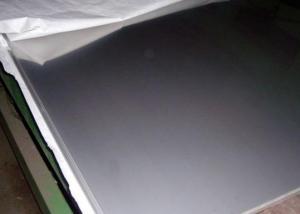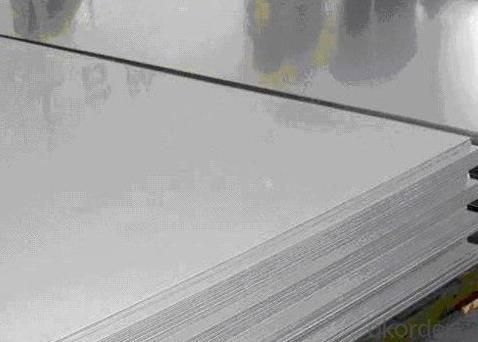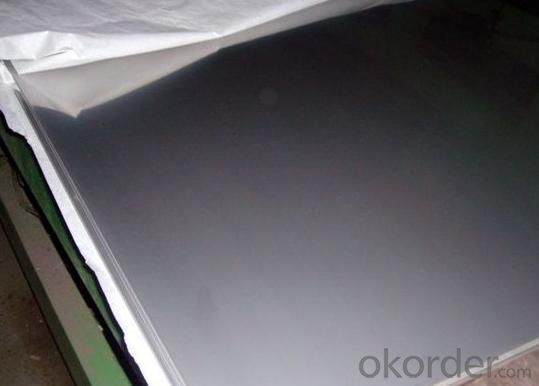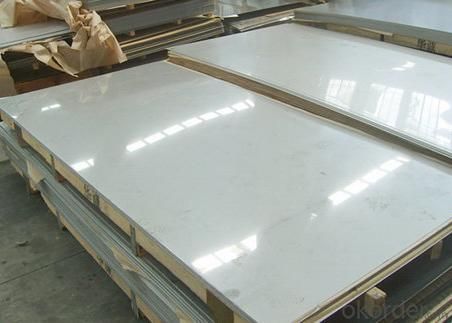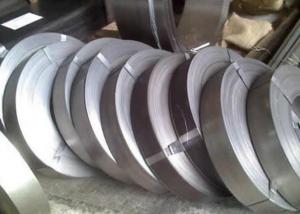316L Stainless Steel Sheet
- Loading Port:
- China Main Port
- Payment Terms:
- TT or LC
- Min Order Qty:
- 1 Ton m.t.
- Supply Capability:
- 1000 Tons Per Month m.t./month
OKorder Service Pledge
OKorder Financial Service
You Might Also Like
316L Stainless steel sheet
1. Chemical composition of 316L Stainless steel sheet
C | Si | Mn | P | S | Ni | Cr |
Max0.03 | max1.00 | max2.00 | max0.045 | max0.03 | 10.00-14.00 | 16.00-18.00 |
2. Mechanical properties of 316L Stainless steel sheet
Yield Strength | Tensile | Elongation | Hardness (HV) | Hardness (HRB) |
≥175 | ≥480 | ≥40 | ≤200 | ≤90 |
3. Standard of 316L Stainless steel sheet : AISI, ASTM, GB, EN, DIN, JIS
4. Surface of 316L Stainless steel sheet : 2B, NO.1, BA, NO.4, Hairline, SB, Mirror finish, Anti-skid, Cherkered etc.
5. Size of 316L Stainless steel sheet :
Thickness: 0.3-3mm (cold rolled), 3-40mm (hot rolled)
Width: 1000mm or 1219mm or 1240mm for cold rolled, 1500mm for hot rolled.
Length: As customers' request.
6. MOQ of 316L Stainless steel sheet : 1 Ton
7. Payment terms of 316L Stainless steel sheet : T/T or L/C
8. Packing of 316L Stainless steel sheet : Seaworthy package with wooden or Iron pallets with the paper and the steel strip,
or as customers' request.
9. Delivery time of 316L Stainless steel sheet : Usually about 7 days after we confirming the order, or according to your quantity
If you have any question or demand, pls feel free to contact me.
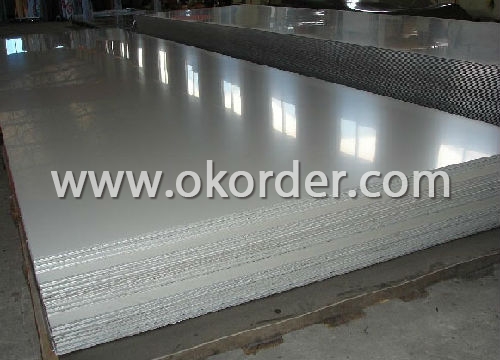
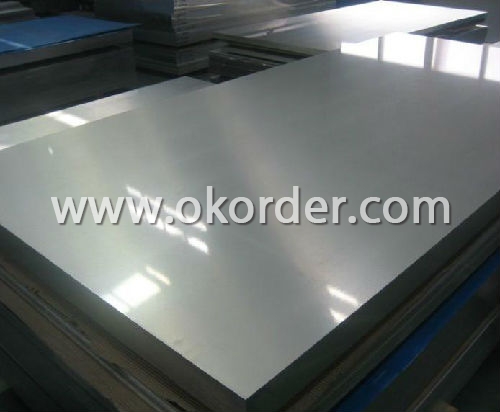
- Q: Can stainless steel strips be used in oil and gas industries?
- Indeed, the oil and gas industries can utilize stainless steel strips. Renowned for its exceptional resistance to corrosion, impressive strength, and long-lasting nature, stainless steel proves to be an optimal material for various applications within the oil and gas sector. By employing stainless steel strips, one can manufacture pipes, tubes, fittings, valves, heat exchangers, and other components that encounter challenging operational conditions such as corrosive surroundings, elevated temperatures, and intense pressures. Moreover, stainless steel boasts commendable weldability and formability, thereby enabling effortless fabrication and installation in oil and gas facilities. In summary, stainless steel strips offer the essential dependability and performance that the oil and gas industry necessitates.
- Q: Are stainless steel strips suitable for water treatment applications?
- Stainless steel strips, indeed, prove to be appropriate for applications in water treatment. Stainless steel boasts exceptional resistance against corrosion and can endure exposure to water and the diverse chemicals commonly utilized in water treatment procedures. Its extraordinary strength and durability render it fitting for implementation in equipment employed in water treatment, such as filters, screens, tanks, and pipes. Moreover, stainless steel exhibits hygienic properties and can be easily cleaned, a crucial aspect in upholding water quality. Its ability to resist bacterial growth and endure high temperatures further establish it as a dependable option for water treatment applications.
- Q: What is the fatigue limit of stainless steel strips?
- The fatigue limit of stainless steel strips represents the highest stress level at which the material can withstand an unlimited amount of stress cycles without encountering fatigue failure. However, it is important to note that the fatigue limit of stainless steel can differ based on various factors, including the specific composition of the alloy, heat treatment, surface finish, and loading conditions. In general, stainless steel is renowned for its superior fatigue strength when compared to other materials. It demonstrates exceptional resistance to fatigue failure due to its inherent properties, such as its high strength, excellent corrosion resistance, and remarkable toughness. The fatigue limit of stainless steel strips can range from approximately 30 to 60 percent of its ultimate tensile strength (UTS), depending on the aforementioned factors. To determine the fatigue limit of a particular stainless steel strip, it is necessary to conduct fatigue testing within a laboratory setting. This involves subjecting the material to repeated cyclic loading at various stress levels until failure occurs. The stress levels are typically plotted against the number of cycles until failure, resulting in the creation of a fatigue curve. Through analysis of the fatigue curve, it becomes possible to identify the fatigue limit at which the material exhibits an infinite lifespan under cyclic loading. This value holds great significance in engineering applications where stainless steel strips will encounter repeated stress cycles, such as in structural components, machine parts, or automotive applications. In conclusion, the fatigue limit of stainless steel strips represents the highest stress level at which the material can withstand an unlimited number of stress cycles without encountering fatigue failure. This value can differ based on several factors and is determined through laboratory testing. Stainless steel is generally recognized for its high fatigue strength, making it a suitable choice for applications demanding exceptional resistance to fatigue failure.
- Q: What is the difference between austenitic and martensitic stainless steel strips?
- Austenitic stainless steel strips have a face-centered cubic crystal structure, which provides high corrosion resistance, excellent formability, and good weldability. On the other hand, martensitic stainless steel strips have a body-centered cubic crystal structure, making them harder and more brittle than austenitic steel. Martensitic steel is known for its high strength and hardness, but it sacrifices some of the corrosion resistance and formability found in austenitic steel.
- Q: How do stainless steel strips resist erosion in abrasive environments?
- Stainless steel strips are highly resistant to erosion in abrasive environments due to their unique composition and properties. The primary factor that enables stainless steel strips to resist erosion is the presence of chromium in the alloy. Chromium forms a thin, invisible layer of chromium oxide on the surface of the steel, which acts as a protective barrier against corrosion and erosion. This chromium oxide layer is extremely stable and adheres tightly to the steel surface, preventing any further oxidation or corrosion from occurring. It effectively seals the steel from the surrounding environment, including abrasive particles, moisture, and other contaminants that could cause erosion. Additionally, stainless steel strips often contain other alloying elements such as nickel and molybdenum, which further enhance their resistance to erosion. These elements contribute to the formation of a passive film that provides an additional layer of protection against abrasion. Furthermore, stainless steel strips are typically engineered to possess a high hardness and strength, making them more resistant to mechanical wear and tear. They can withstand the impact and friction caused by abrasive particles without significant damage or erosion. Moreover, the smooth surface finish of stainless steel strips reduces the likelihood of particles getting trapped or lodged in microscopic crevices, minimizing the potential for erosion. This smoothness also facilitates easy cleaning and maintenance, ensuring the longevity of the stainless steel strips in abrasive environments. In summary, stainless steel strips resist erosion in abrasive environments primarily through the formation of a protective chromium oxide layer, their high hardness and strength, and their smooth surface finish. These factors work together to provide excellent resistance against corrosion, mechanical wear, and the detrimental effects of abrasive particles.
- Q: What are the common dimensions of stainless steel strips?
- The common dimensions of stainless steel strips can vary depending on the specific application and industry requirements. However, some commonly available dimensions include thicknesses ranging from 0.1mm to 3mm, widths ranging from 10mm to 500mm, and lengths ranging from a few meters to coils of several hundred meters.
- Q: Can stainless steel strips be customized according to specific requirements?
- Certainly! Stainless steel strips have the capability to be personalized in accordance with specific needs. Stainless steel, being a flexible material, can be easily molded, trimmed, and modified into diverse forms and dimensions. This permits customization to fulfill particular requirements, including width, thickness, length, and surface quality. Furthermore, stainless steel strips can undergo additional customization through techniques such as slitting, edge treatment, and surface refinement to enhance their functionality and aesthetics. Regardless of whether it is for industrial, architectural, or decorative purposes, stainless steel strips can be meticulously tailored to precisely match the specifications and demands of a specific application.
- Q: Do you have stainless steel with magnetic?
- Austenitic stainless steel is the stainless steel with austenite structure at normal temperature. When the steel containing Cr is about 18%, Ni, 8%~10% and C is about 0.1%, it has a stable austenite structure. Austenitic chromium nickel stainless steel includes the famous 18Cr-8Ni steel, and on this basis, increasing the content of Cr, Ni, and adding Mo, Cu, Si, Nb, Ti and other elements developed by the high Cr-Ni series steel.
- Q: Can stainless steel strips be used in telecommunications equipment?
- Yes, stainless steel strips can be used in telecommunications equipment. Stainless steel is often chosen for its durability, corrosion resistance, and strength. These properties make stainless steel strips suitable for various applications in telecommunications equipment, such as cable support brackets, antenna mounts, enclosures, and cable trays. Stainless steel's resistance to rust and corrosion ensures that the equipment remains reliable and functional, even in harsh environmental conditions. Additionally, stainless steel's strength allows it to withstand the weight and stress of heavy equipment and cables, making it a preferred choice in the telecommunications industry.
- Q: What are the factors affecting the corrosion resistance of 111 stainless steel strips?
- The factors affecting the corrosion resistance of 111 stainless steel strips include the composition of the stainless steel, the presence of impurities, the surface finish, the temperature and environment in which it is exposed, and the presence of corrosive substances such as acids or salts.
Send your message to us
316L Stainless Steel Sheet
- Loading Port:
- China Main Port
- Payment Terms:
- TT or LC
- Min Order Qty:
- 1 Ton m.t.
- Supply Capability:
- 1000 Tons Per Month m.t./month
OKorder Service Pledge
OKorder Financial Service
Similar products
Hot products
Hot Searches
Related keywords
